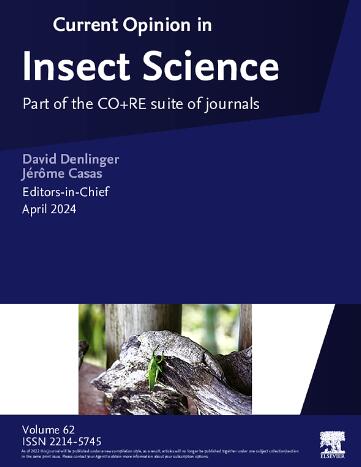病毒在绦虫多营养相互作用中的作用及生物防治的展望。
IF 4.8
1区 农林科学
Q1 BIOLOGY
引用次数: 0
摘要
绦虫果蝇是困扰世界各国农业水果生产的一大难题。不依赖于合成杀虫剂的新控制方法越来越需要多样化的绦虫病虫害管理方案。尽管影响果蝇寄生蜂成功的分子因素还未得到充分研究,但通过释放寄生蜂的生物防治在历史上有效地抑制了果蝇害虫。微生物已被证明可以促进昆虫和环境之间的无数相互作用,并已成为最近在伤寒中调查的主题。具体来说,在果蝇和相关的拟寄生虫中发现的病毒的多样性和功能是一个新兴的研究领域,它有可能加深我们对以前隐藏的因素的理解,这些因素促进了害虫的可持续控制。迄今为止,大多数工作都集中在使用宏基因组和亚转录组测序方法鉴定果蝇体内的驻留病毒群落。此外,越来越多的证据揭示了病毒与果蝇宿主之间的多种功能动力学,包括垂直传播的共生病毒和寄生虫载体病原体。特别是由果蝇类寄生物传播的可遗传病毒在果蝇多营养相互作用中发挥着重要作用,在这种相互作用中,病毒感染可以塑造被感染的类寄生物的存活率和宿主范围。此外,至少有一种类寄生虫病毒对多种果蝇害虫是致命的病原体。因此,拟寄生虫病毒可能为利用自然拮抗相互作用进行果蝇害虫控制创新提供了新的机会。本文章由计算机程序翻译,如有差异,请以英文原文为准。
The roles of viruses in tephritid pest multitrophic interactions and an outlook for biological control
Tephritid fruit fly pests remain a considerable problem for agricultural fruit production around the world. New control methods that do not rely on synthetic insecticides are increasingly desirable to diversify tephritid pest management programs. Biological control through the release of parasitoid wasps has historically provided effective suppression of fruit fly pests, although molecular factors that influence the success of fruit fly parasitoids are understudied. Microbes have been demonstrated to facilitate myriad interactions between insects and their environment and have been the subject of recent investigation within tephritids. Specifically, the diversity and function of viruses found within fruit flies and associated parasitoids is an emerging field of research that has the potential to deepen our understanding of previously hidden factors that facilitate sustainable pest control. Most work to date has focused on identifying resident viral communities within fruit flies using metagenomic and metatranscriptomic sequencing approaches. Additionally, a growing body of evidence has revealed a multitude of functional dynamics that viruses have with fruit fly hosts, including vertically transmitted commensal viruses and parasitoid-vectored pathogens. Heritable viruses transmitted by fruit fly parasitoids, in particular, have been shown to play prominent roles in fruit fly multitrophic interactions, in which viral infection can shape the survival rate and host range of infected parasitoids. Furthermore, at least one parasitoid virus represents a lethal pathogen to a wide range of fruit fly pest species. Parasitoid viruses could therefore present novel opportunities to leverage natural antagonistic interactions for fruit fly pest control innovations.
求助全文
通过发布文献求助,成功后即可免费获取论文全文。
去求助
来源期刊

Current opinion in insect science
BIOLOGYECOLOGYENTOMOLOGY-ECOLOGY
CiteScore
10.40
自引率
1.90%
发文量
113
期刊介绍:
Current Opinion in Insect Science is a new systematic review journal that aims to provide specialists with a unique and educational platform to keep up–to–date with the expanding volume of information published in the field of Insect Science. As this is such a broad discipline, we have determined themed sections each of which is reviewed once a year.
The following 11 areas are covered by Current Opinion in Insect Science.
-Ecology
-Insect genomics
-Global Change Biology
-Molecular Physiology (Including Immunity)
-Pests and Resistance
-Parasites, Parasitoids and Biological Control
-Behavioural Ecology
-Development and Regulation
-Social Insects
-Neuroscience
-Vectors and Medical and Veterinary Entomology
There is also a section that changes every year to reflect hot topics in the field.
Section Editors, who are major authorities in their area, are appointed by the Editors of the journal. They divide their section into a number of topics, ensuring that the field is comprehensively covered and that all issues of current importance are emphasized. Section Editors commission articles from leading scientists on each topic that they have selected and the commissioned authors write short review articles in which they present recent developments in their subject, emphasizing the aspects that, in their opinion, are most important. In addition, they provide short annotations to the papers that they consider to be most interesting from all those published in their topic over the previous year.
 求助内容:
求助内容: 应助结果提醒方式:
应助结果提醒方式:


